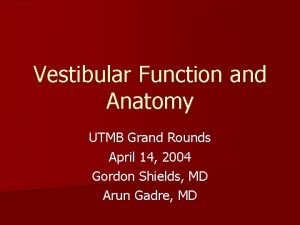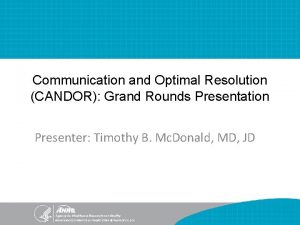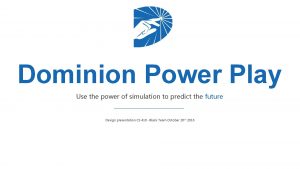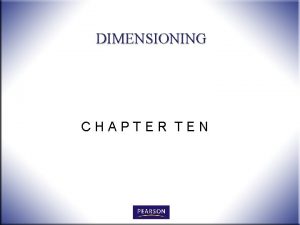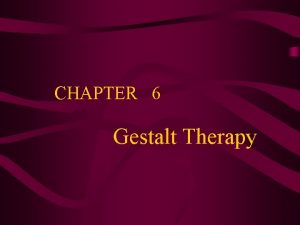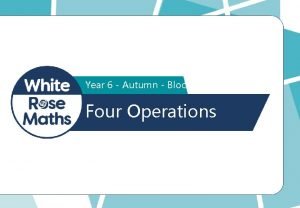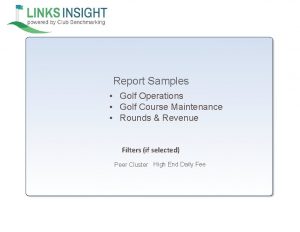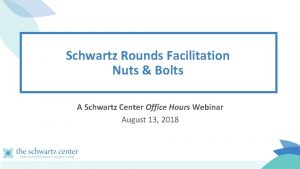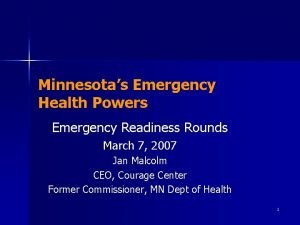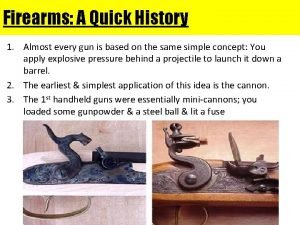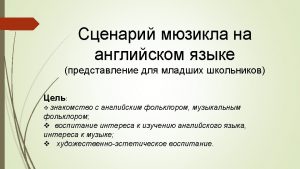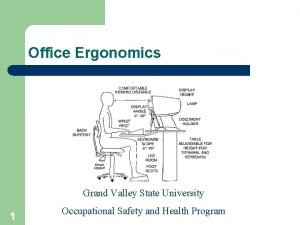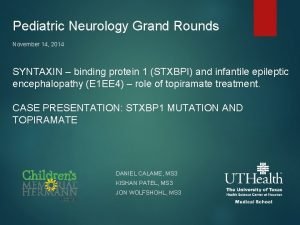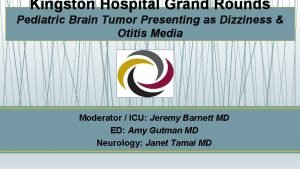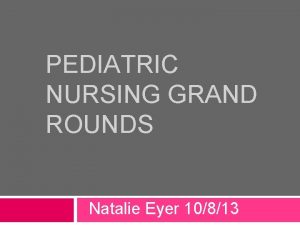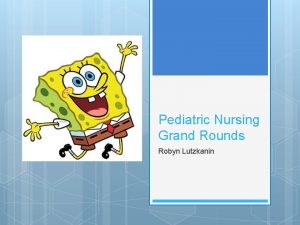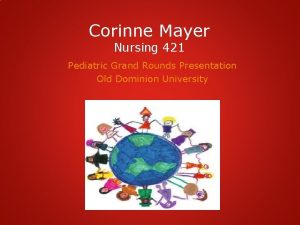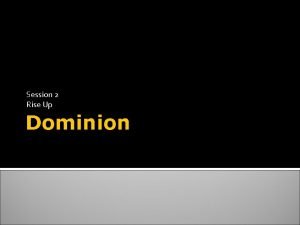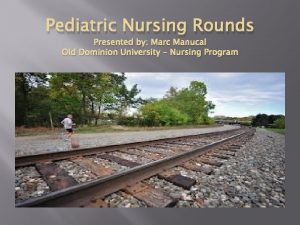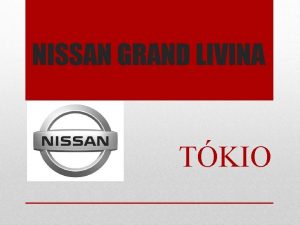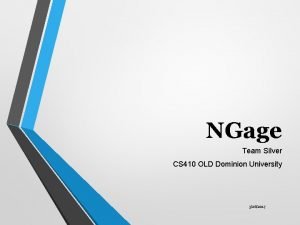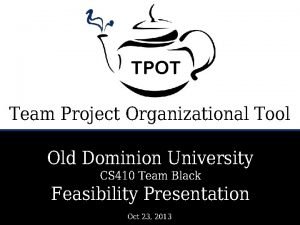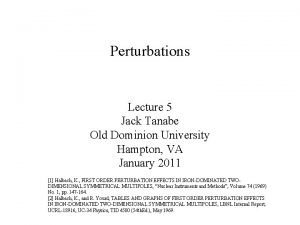Pediatric Grand Rounds CARL ROJAS OLD DOMINION UNIVERSITY




































- Slides: 36

Pediatric Grand Rounds CARL ROJAS OLD DOMINION UNIVERSITY SCHOOL OF NURSING

Objectives Define Pectus Excavatum & Carinatum Medical/Surgical Client Interventions History & Assessment Nursing Problems/Plan of Care Relevant Research

Pectus Excavatum A condition in which a person’s breastbone is sunken into the chest, which is often noticeable shortly after birth & may worsen during an adolescent’s growth spurt.

Pectus Carinatum A. K. A. “Pigeon Chest” Malformation of the chest characterized by a protrusion of the sternum and ribs Often becomes more pronounced during puberty. Affects x 4 as many males than females

Types of Pectus Defects Pectus Excavatum Pectus Carinatum

Types of Pectus Defects Mixed Defect Combination of excavatum & carinatum.

Risk Factors Pectus Excavatum Pectus Carinatum Marfan Syndrome Ehlers-Danlos Syndrome Osteogenesis Imperfecta Metablic Disorders Noonan Syndrome Turner Syndrome Morquio Syndrome Brittle Bone Disease Chromosomal Abnormalities

Symptoms Pectus Excavatum Pectus Carinatum Decreased Exercise Tolerance SOB w/exertion Rapid heartbeat/palpitations Chest pain/tenderness Recurrent respiratory infections Wheezing or Coughing Asthma Chest Pain Fatigue Heart Murmur Rapid heart rate/pl Fatigue

Health Complications • Chest Pain • Respiratory Issues • Infection • Physiological Developmental Issues • Heart Disease

Health Complications Anything Else? ? ?

Diagnostics X-Ray Pulmonary Function Test Computed Tomography (CT) or Magnetic Resonance Imaging (MRI) Tests for Related Conditions Physicians may delay course of treatment until after puberty. Why? ? ?

Treatment: Ravitch Repair Surgical removal of portions of the cartilaginous ribs as well as releasing & reconnecting the attachments between the rectus muscle & sternum. Insertion of a curved metal bar under ribs & sternum Once positioned & chest has taken the correct shape, a stabilizer bar is attached to the bar & connects to the ribs to prevent bar from slipping. Average length of placement = 2 -3 years Average length of inpatient stay = 3 -5 days

Nuss Procedure https: //youtu. be/T-E 5 e. Sraul. Y

Treatment Criteria Pectus/Medical Questionnaire CT Scan/MRI Haller Index > 3. 2 Cardiac Compression, Displacement, or Distortion of shape Pulmonary Compression, Presence of Atelectasis, Distortion of Shape, or Skeletal (rib or vertebral) anomalies Pulmonary Function Test Electrocardiogram Echocardiogram Metal Allergy Testing

History of Present Illness 19 y/o Caucasian female POD 2 for ravich repair of mixed pectus excavatum/carinatum deformity that has been present since age 1. Symptoms began to worsen over the last few months to include chest px as well as SOB & lack of endurance w/exertion.

Client History PMHx Mixed congenital excavatum/carinatum deformity since age 1 Neurofibromatosis type I Bed wetting Family Hx of Asthma (sister) & Pectus Excavatum (Mother) Social Hx College freshman Lives at home w/parents & sister

Clinical Work Up MRI showed mixed defect with a haller index of 4. 38 at the excavatum portion. PFT – FVC 80%; FEV 1 79%; FEF 25 -75%, 76% Cardiac Normal ECG ECHO – mild aortic insufficiency, trivial pulmonary valve insufficiency, trivial mitral regurgitation & trivial tricuspid valve regurgitation

Patient Assessment HT: 152 cm (4%); WT: 41. 5 kg (1%), Px controlled w/PCA General Appearance: A&Ox 4 w/fatigue; activity intolerance Respiratory Bilateral lower lobe crackles, RR @ 26, short inspirations, O 2 Sat 88% on 2 L NC Blake Drain JP Drain – 25 ml GI & GU Currently experiencing N/V; unable to hold down food/fluids Continuous fluids IV DTV @ 12: 00 Skin: Incision bandages clear – no drainage

Patient Assessment Chemistry Anion Gap 7 Na+ 137 K+ 4. 7 Cl- 108 CO 2 22 BUN 7 Creatinine 0. 4 Glucose 102 Ca+ 7. 3 Hemolysis Interpretation?

Patient Inpatient Medications Cefazolin 1000 mg/10 ml IV push q 6 h Dexamethasone 6 mg/1. 5 ml IV push Diazepam 2 mg/0. 4 ml IV push q 6 h Electrolyte Solution 1000 ml IV bolus x 2 Fentanyl 50 mcg/ml IV push Glycopyrrolate 0. 4 mg/2 ml IV push Hydromorphone 0. 4 mg/0. 4 ml IV push Ketamine 10 mg/ml IV push Lidocaine 10 mg/ml IV push Midazolam 20 mg/10 ml liquid PO Neostigmine 1 mg/ml IV push Ondansetron 4 mg/2 ml IV push Morphine 2 mg/0. 2 ml IV push PRN Promethazine 6. 25 mg/0. 25 ml IV piggyback qr 4 h PRN D 5 -1/2 NS w/KCl 20 m. Eq/L 1000 ml IV continuous at rate of 80 ml/hr

Patient Discharge Medications Percocet Robaxin (Methocarbamol) Ibuprofen (Motrin) Valium (Diazepam) Colace (Docusate Sodium) Zofran (Ondansetron)

Developmental Stage Identity vs Role Confusion (Puberty) Preoccupation w/appearance & body image Intimacy vs Isolation (Young Adult) Searching for meaningful friendships & an intimate relationship w/another person.

Maslow’s Hierarchy of Needs

Concept Map 1. Ineffective Breathing Pattern 2. Acute Pain Nursing Diagnoses 3. Impaired Skin Integrity 4. Deficient Knowledge

Nursing Diagnosis (Priority) Ineffective Breathing Pattern Related to: Decreased lung expansion Drugs that suppress the cough reflex and respiratory center Fluid accumulation & chest tube drains Characterized by Short & shallow respirations w/inhalation Nausea & vomiting 88% O 2 saturation Pain with respirations Fatigue

Priority Outcomes & Interventions Desired Outcome Establish a normal/effective respiratory pattern free of cyanosis or other signs of hypoxia throughout hospitalization. Interventions Auscultate breath sounds & listen for adventitious breath sounds. Observe respiratory rate & depth, chest expansion, use of accessory muscles, retraction or flaring of nostrils, skin color; note airflow. Monitory vital signs Elevate HOB as appropriate & ambulate as soon as possible. Administer supplemental O 2 as indicated. Encourage deep breathing exercises – i. e. incentive spirometer.

Nursing Diagnosis (Secondary) Acute Pain related to surgical procedure involving removal of cartilage tissue from chest wall as evidenced by reports of pain and autonomic responses. Impaired Skin Integrity related mechanical interruption of Deficient Knowledge related to complexity of treatment plan skin/tissues as evidenced by disruption of skin surface from drainage tube placement. characterized by inability to focus when being educated.

Potential Nursing Diagnoses Acute Risk for Infection Impaired Urinary Elimination & Constipation Risk for Bleeding Chronic Self-Care Deficit Ineffective Coping Risk for Injury

Nursing Interventions Acute Pain Impaired Skin Integrity Evaluate px q 2 h noting characteristics, location, & intensity. Emphasize patient’s responsibility for reporting pain/relief of pain completely. • • Check tension of dressings. • Assess causes of possible discomfort other than operative procedure. • Inspect wound regularly, noting characteristics & integrity. Note signs of delayed healing. • Patient-controlled analgesia (PCA) & Provide around-theclock analgesia w/intermittent rescue doses • Assess amounts & characteristics of drainage. • Maintain patency of drainage tubes. Note amount of drainage collected & characteristics. • Reinforce initial dressing & change as indicated using strict aseptic techniques. Deficient Knowledge • Continuously assess patient’s level of understanding. • Discuss individual postoperative pain management plan. Identify misconceptions patient may have & provide appropriate information. • Provide opportunities for patient to demonstrate what has been taught (i. e. incentive spirometer, due to void time, use of PCA).

Overall Expected Outcomes <3/10 px w/DC of PCA prior to discharge Ambulation to chair w/assistance x 2 w/in 24 hours Oxygen saturation >92% on RA within 24 hours >500 ml expiration volume w/ICS Consumption of 75% of plate at each meal w/in 24 hours Incisional site bandages will show no evidence of infection prior to DC Patient will void w/in 6 hrs of discontinuation of foley Patient/parent will provide nurse w/instructions for physical limitations of patient prior to DC. Patient/parent will instruct nurse on 2 exercises to conduct at home prior to DC.

Interdisciplinary Health Care Surgeon Pediatrician Physical Therapy Care Manager Nursing Care Family & Patient

Discharge Planning EDUCATION, EDUCATION!!! Pain management routine & Rx regimen Follow up Appointments 3 weeks 6 month 18 month - PFT Annual 1 year post removal of bar implant Medic Alert Bracelet

Research: Improving Quality of Life Physical Functioning General Health Role/Social: emotional & behavioral Family Activities Role/Social: physical Parental Impact-Time Bodily Pain Parental Impact-Emotional Behavior Family Cohesion Mental Health Global Health Self esteem Global Behavior Change in Health

Questions

References Lomholt, J. J. , Jacobsen, E. B. , Thastum, M. , & Pilegaard, H. (2016). A prospective study on quality of life in youths after pectus excavatum correction. Annals of Cardiothoracic Surgery, 5(5), 456– 46 Swearingen, P. (2008). All-in-one care planning resource (2 nd ed. ). St. Louis, MS: Mosby Elsevier. Gulanick, M. , & Myers, J. L. (2014). Nursing care plans (8 th ed. ). Philadelphia, PA: Mosby Elsevier. Halter, M. J. , (2018). Varcarolis’ foundations of psychiatric-mental health nursing: A Clinical Approach, 8 th Edition. St. Louis, Missouri: Elsevier Inc. 5. http: //doi. org/10. 21037/acs. 2016. 08. 02 Honor Code Children’s Hospital of The King’s Daughters. (n. d. ). Nuss center. Retrieved from http: //www. chkd. org/Our-Services/Nuss-Procedure/

Honor Code “I pledge to support the Honor System of Old Dominion University. I will refrain from any form of academic dishonesty or deception, such as cheating or plagiarism. I am aware that as a member of the academic community it is responsibility to turn in all suspected violators of the Honor Code. I will report to a hearing if summoned. ” Carl Rojas 6/20/2018
 Is old dominion university accredited
Is old dominion university accredited Utmb grand rounds
Utmb grand rounds Duke family medicine and community health
Duke family medicine and community health Nursing grand rounds presentation example
Nursing grand rounds presentation example Dominion mandate meaning
Dominion mandate meaning Dominion simulator
Dominion simulator Strategi pesaing kecil
Strategi pesaing kecil Horses by ted hughes poem
Horses by ted hughes poem Ius in agro vectigali
Ius in agro vectigali United dominions trust ltd v kirkwood
United dominions trust ltd v kirkwood Standard choice offer dominion east ohio
Standard choice offer dominion east ohio We are never never weary
We are never never weary Round 75 to the nearest ten
Round 75 to the nearest ten Christmas table quiz seomra ranga
Christmas table quiz seomra ranga Tabular dimensioning
Tabular dimensioning 5 layers of neurosis
5 layers of neurosis A is an odd number which rounds to 100 000
A is an odd number which rounds to 100 000 Maintenance rounds
Maintenance rounds Schwartz rounds facilitator training
Schwartz rounds facilitator training Sam rounds
Sam rounds Quality teaching rounds coding sheet
Quality teaching rounds coding sheet Red, white & blue bite size rounds tortilla chips
Red, white & blue bite size rounds tortilla chips Readiness rounds
Readiness rounds Chamber mark
Chamber mark Harvard instructional rounds
Harvard instructional rounds How old old are you
How old old are you Once upon a time there lived an ant and a butterfly
Once upon a time there lived an ant and a butterfly Once upon a time there lived an old man and an old woman
Once upon a time there lived an old man and an old woman Hansel once upon a time
Hansel once upon a time Grand valley state university occupational therapy
Grand valley state university occupational therapy Robert r rojas
Robert r rojas Patricio rojas quezada
Patricio rojas quezada Maniobra de mauriceau
Maniobra de mauriceau Las media rojas
Las media rojas La celestina género literario
La celestina género literario Anabel rojas
Anabel rojas Cassandra rojas
Cassandra rojas

